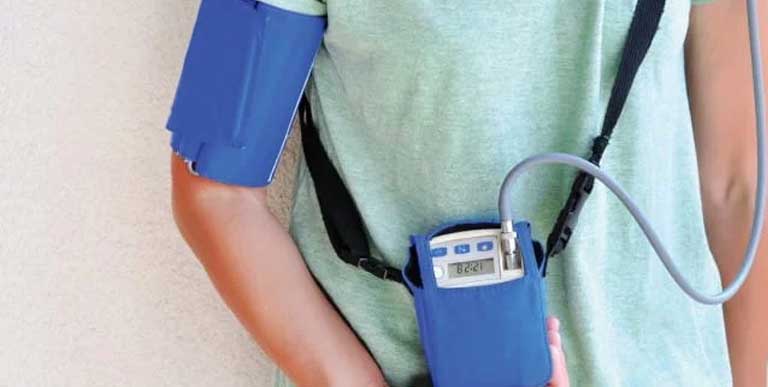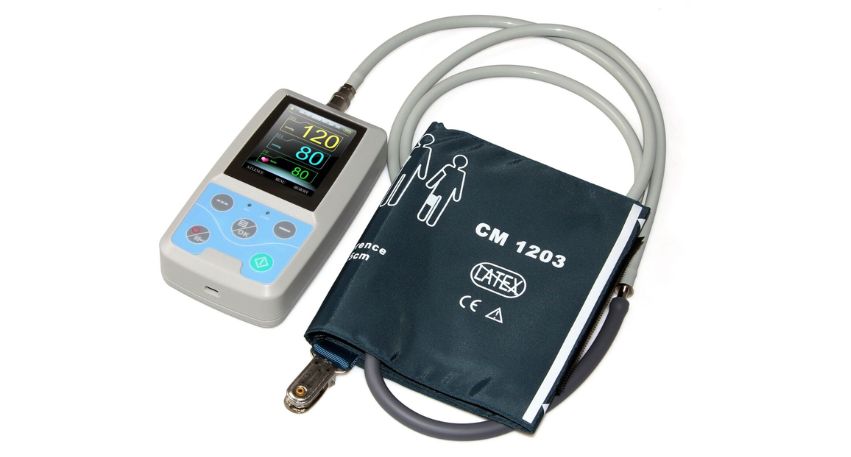Comprehending the Significance of the ABPM Test in Hypertension Administration
Ambulatory Blood Pressure Monitoring (ABPM) is a pivotal tool in taking care of hypertension. By supplying continuous blood pressure readings over 1 day, it offers understandings that typical measurements can not. This technique can disclose problems such as white layer disorder and masked high blood pressure. Understanding these subtleties is crucial for efficient client care. As healthcare progresses, the effects of ABPM in forming tailored therapy methods come to be significantly substantial. What does this mean for the future of high blood pressure management?
What Is Ambulatory Blood Pressure Monitoring (ABPM)?
Ambulatory Blood Pressure Monitoring (ABPM) is a technique that enables for the continual dimension of blood pressure over a 24-hour period while clients take part in their everyday tasks. This cutting-edge method includes the usage of a mobile gadget that automatically takes blood pressure readings at established intervals, normally every 15 to half an hour. ABPM supplies a detailed account of blood pressure variations throughout the day and evening, recording variants that may be missed throughout standard workplace measurements.It is particularly useful for detecting problems such as hypertension and white coat disorder, where clients show elevated analyses only in medical settings. By supplying real-time information, ABPM improves the accuracy of high blood pressure assessments and aids in customizing therapy strategies. The insights gained from this monitoring may cause much better administration of cardio health, enhancing the importance of ABPM in contemporary clinical method.
How ABPM Varies From Typical Blood Pressure Measurements
While conventional blood pressure measurements commonly count on readings absorbed a clinical setup, ABPM provides a more substantial method by evaluating blood pressure over a complete 24-hour period. Conventional approaches typically produce a restricted variety of analyses that may not capture fluctuations in blood pressure throughout the day. On the other hand, ABPM enables continuous monitoring, providing understandings right into variations during different activities, such as resting and exercising.Additionally, traditional measurements may be affected by the person's anxiousness during a physician's browse through, known as "white coat syndrome," possibly leading to inaccurately high analyses. ABPM minimizes this problem by gathering data in an acquainted setting, generating a more precise representation of a person's blood pressure. The gadget typically takes measurements at regular periods, guaranteeing comprehensive information collection. This basic distinction highlights the relevance of ABPM in offering a total photo of a person's blood pressure profile.
Benefits of ABPM in High Blood Pressure Monitoring
Using Ambulatory Blood Pressure Monitoring (ABPM) provides considerable advantages in handling high blood pressure. It provides precise and continual blood pressure readings, assisting to identify problems such as white coat syndrome. This accurate data enables doctor to make even more customized treatment changes tailored to private person demands.
Precise Blood Pressure Monitoring

Identifying White Layer Syndrome
Ambulatory Blood Pressure Monitoring (ABPM) plays a significant role in recognizing white coat disorder, a sensation where patients exhibit raised blood pressure analyses in a professional setting yet preserve regular degrees in their day-to-day lives. This problem can cause misdiagnosis and unnecessary therapy, complicating high blood pressure administration. ABPM supplies a comprehensive evaluation of blood pressure over a 24-hour duration, capturing variants that occur throughout daily tasks and rest. By comparing these analyses to facility measurements, doctor can compare true hypertension and white layer disorder. Inevitably, recognizing this syndrome is important for customizing appropriate therapy techniques and stopping overtreatment, making sure that individuals obtain care that properly reflects their blood pressure status outside the clinical environment.
Customized Therapy Changes
Enhancing high blood pressure monitoring through individualized therapy modifications ends up being feasible with the understandings obtained from ABPM. This approach supplies constant blood pressure monitoring, permitting health care companies to recognize patterns and variations that may not be apparent throughout conventional office gos to. By recognizing a patient's one-of-a-kind blood pressure profile, clinicians can tailor treatment plans that consider factors such as drug effectiveness, lifestyle influences, and private reaction to therapy. This individualized strategy not just enhances client adherence yet also enhances general outcomes by minimizing the risk of problems related to uncontrolled high blood pressure. Eventually, using ABPM encourages medical professionals to make informed choices, resulting in more effective monitoring techniques that align with each person's specific demands.
Identifying White Layer High Blood Pressure and Masked Hypertension
White coat high blood pressure occurs when individuals display raised blood pressure readings in a clinical setting as a result of anxiety, while their measurements are regular in various other environments. On the other hand, concealed high blood pressure describes individuals whose blood pressure is typical during medical visits however elevated in everyday life. Comprehending these two sensations is vital for precise high blood pressure monitoring and therapy choices.
Specifying White Coat High Blood Pressure
High blood pressure management usually includes comparing different blood pressure problems, specifically white coat high blood pressure and masked hypertension. White layer hypertension is identified by elevated blood pressure readings in professional settings, commonly due to stress and anxiety associated with medical environments. People with this problem normally display typical blood pressure levels beyond these settings. This phenomenon can cause misdiagnosis and unnecessary treatment if not properly identified. It is essential for healthcare suppliers to identify this problem to stay clear of overtreatment and to assure accurate high blood pressure monitoring. ABPM test in Bangalore. The use of ambulatory blood pressure monitoring (ABPM) can assist distinguish white coat hypertension from continual high blood pressure, allowing much more reliable and tailored therapy methods for people experiencing this special blood pressure feedback
Recognizing Masked Hypertension
Masked high blood pressure postures a significant Get More Info challenge in high blood pressure monitoring, as it often goes undiscovered in clinical settings. This condition occurs when a patient's blood pressure analyses are normal throughout clinical check outs yet elevated at home or during everyday activities. Unlike white layer high blood pressure, where stress and anxiety in a medical setting results in temporary spikes in blood pressure, concealed hypertension can result in unrecognized cardiovascular threats. Individuals may think they have normal blood pressure, disregarding necessary way of living adjustments or therapies. Determining concealed high blood pressure is necessary, as it can bring about significant health and wellness complications gradually. Ambulatory Blood Pressure Monitoring (ABPM) is an efficient tool for discovering this problem, enabling healthcare experts to provide timely intervention and enhance individual end results.
The Role of ABPM in Personalized Treatment Plans
As medical care carriers significantly recognize the importance of individualized care, the execution of Ambulatory Blood Pressure Monitoring (ABPM) has come to be crucial in customizing therapy plans for individuals with high blood pressure. ABPM permits continual blood pressure dimension over 24 hours, revealing patterns that might be missed throughout basic office sees. This extensive information supplies insights right into a person's blood pressure variability and nighttime degrees, which are essential for comprehending overall cardio danger.
Interpreting ABPM Results: Understanding Patterns and Patterns
Translating the arise from Ambulatory Blood Pressure Monitoring (ABPM) requires an eager understanding of numerous patterns and patterns that emerge from the collected information. Clinicians assess the 24-hour blood pressure account, identifying in between daytime and nighttime readings to determine prospective white-coat high blood pressure or concealed hypertension. A constant elevation in daytime analyses might suggest inadequately regulated high blood pressure, while nighttime dips can signify reliable blood pressure management or nocturnal high blood pressure, which postures additional cardio risks.Trends with time, such as sustained increases or fluctuations, are likewise essential. Variability in analyses can recommend underlying concerns, such as stress and anxiety or medication non-adherence. Additionally, the evaluation of blood pressure patterns in relation to daily tasks can supply understandings right into way of living variables impacting hypertension. By carefully interpreting these outcomes, medical care professionals can customize therapy techniques to improve individual end results in hypertension administration, eventually resulting in much better cardio health.
The Future of Blood Pressure Monitoring and Hypertension Care
Emerging modern technologies and developments are positioned to change blood pressure monitoring and hypertension care in the coming years. Wearable gadgets outfitted with advanced sensing units are expected to offer continual, real-time blood pressure analyses, permitting even more customized therapy programs. These devices will certainly not just look at this web-site improve patient interaction however also promote remote monitoring by health care companies, bring about prompt interventions.Artificial knowledge and device learning formulas will play a necessary role in evaluating person information, recognizing patterns, and anticipating hypertension-related complications. This anticipating capability can bring about even more positive administration approaches. Furthermore, telehealth services will likely increase, making it possible for individuals to seek advice from with experts and receive tailored guidance without the demand for in-person visits.Furthermore, advancements in mobile applications may equip patients to track their blood pressure individually, fostering a sense of possession over their wellness. Generally, the future of blood pressure monitoring and hypertension care shows up promising, with technology at its center.
Regularly Asked Inquiries

The length of time Does an ABPM Test Typically Last?
The ABPM test normally lasts 24 hr. During this period, a portable gadget actions blood pressure at regular intervals, supplying substantial information on a patient's blood pressure patterns throughout day-to-day activities and sleep.
Can ABPM Be Used for Children and Teenagers?
ABPM can certainly be made use of for children and adolescents - ABPM test in Bangalore. It supplies useful insights right into their blood pressure patterns, assisting healthcare suppliers precisely identify and handle hypertension in younger populaces, advertising better long-term health and wellness outcomes

What Should I Prevent Prior To Taking an ABPM Test?

Prior to taking an ABPM test, anchor people should avoid high levels of caffeine, pure nicotine, and laborious workout, as these can momentarily elevate blood pressure readings. In addition, it's recommended to refrain from putting on limited apparel that might prevent measurement precision.
Just how Commonly Should I Undergo ABPM Testing?
The regularity of ABPM screening varies based upon private health demands. Typically, it is recommended every six to twelve months, especially for those with unrestrained hypertension or substantial modifications in blood pressure medication. Regular monitoring help reliable management.
Is ABPM Covered by Insurance Coverage Strategies?
The coverage of ABPM testing by insurance plans differs substantially. People need to consult their certain insurance companies to determine eligibility and any type of prospective out-of-pocket expenditures connected with this diagnostic procedure for high blood pressure management.